

Meeting Basics. So Why Do We Still Have Meetings?
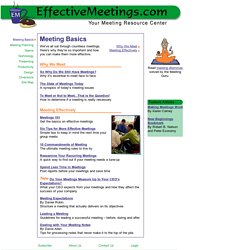
Why it's essential to meet face to face The State of Meetings Today A synopsis of today's meeting issues To Meet or Not to Meet...That is the Question! How to determine if a meeting is really necessary. Master Facilitator Journal Archives: Directory of articles on facilitation, training, and organizational development. Dont Just Do Something, Stand There!: Ten Principles for Leading Meetings ... - Marvin Weisbord. Welcome to Forbes. Dealing with Team Members Who Derail Meetings. What does your team do when someone takes a meeting off-track?

If your team is like most, the leader says something like, “Lee, that’s not what we’re talking about now” or “Let’s get back on track” or the team simply ignores Lee’s comment and tries to bring the conversation back to the original topic. But if your team responds in any of these ways, Lee may continue to press his off-track point, the meeting may drag on with members getting more frustrated with Lee, and the team won’t accomplish its meeting goals. Or Lee may stop participating for the rest of the meeting and the team, without realizing it, loses Lee’s critical input and support for implementing a team decision. If you assume that Lee or others who derail a meeting are the problem and the solution is to get them back on track or stop them from talking, you may also be off-track. These team members’ behaviors are often a symptom of larger team problems. Agree on the track before going down it. Teams, Minimize Meeting Mutiny.
Your team has spent the last three hours in a meeting trying to make a decision about your latest promotional campaign.
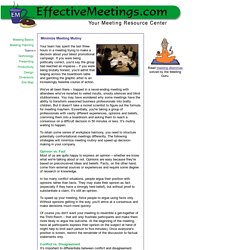
If you were being politically correct, you'd say the group had reached an impasse – if you were being brutally honest, you'd admit that leaping across the boardroom table and garroting the graphic artist is an increasingly feasible course of action. We've all been there – trapped in a never-ending meeting with attendees who've reverted to veiled insults, snooty silences and blind stubbornness. You may have wondered why some meetings have the ability to transform seasoned business professionals into bratty children. But it doesn't take a rocket scientist to figure out the formula for meeting mayhem. Teams, Facilitate This! Using a facilitator is usually a good idea if you want to keep a meeting focused and productive.

Can meetings be effective without a facilitator? Of course. Teams, Avoid Interruptions. Dealing with people who interrupt is a common obstacle in business meetings, but it's one that can be easily overcome with a little planning and confidence.
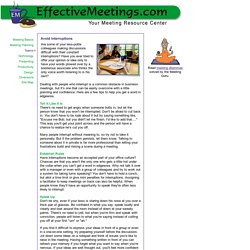
Here are a few tips to help you get a word in edgewise. Tell It Like It Is There's no need to get angry when someone butts in, but let the person know that you won't be interrupted. Don't be afraid to cut back in. You don't have to be rude about it but try saying something like, "Excuse me Bob, but you didn't let me finish. I'd like to add that. …" This way you'll get your point across and the person will have a chance to realize he's cut you off. Teams, Are You Dealing with a Meeting Bully?
In today's team-focused work environment, organizations recognize the benefits of input from a variety of perspectives and people.
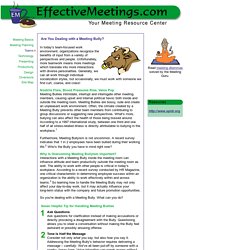
Unfortunately, more teamwork means more meetings which translate into more interactions with diverse personalities. Generally, we can all work through individual socialization styles, but occasionally, we must work with someone we find curt, coarse, and crass! Nostrils Flare, Blood Pressures Rise, Veins Pop Meeting Bullies intimidate, interrupt and interrogate other meeting members, causing upset and internal political havoc both inside and outside the meeting room. Teams, Workplace Warrior. When you're dealing with heroes and villains in a movie, the plot is simple.

The hero has to find the villain and take him down (and in most cases, indulges in a little romance on the side). There are several ways the hero can confront his nemesis, but the most common method is total annihilation – machine guns, hand grenades and the obligatory car chase through New York City. Teams, How To Manage Meeting Malcontents. Teams, The Heroes and Villains in Your Meetings. Have you ever recognized the theater in your group’s meetings?
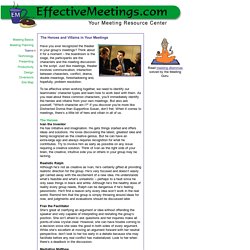
Think about it for a moment – the boardroom is the stage, the participants are the characters and the meeting discussion is the script. Just like meetings, theater involves communication, interaction between characters, conflict, drama, double meanings, foreshadowing and, hopefully, problem resolution. To be effective when working together, we need to identify our teammates’ character types and learn how to work best with them. As you read about these common characters, you’ll immediately identify the heroes and villains from your own meetings. But also ask yourself, "Which character am I? " Teams, Mitigating Meeting Sabotage. You're a meeting pro.

You set goals. You come on time. You come prepared. You even know how to deal with meeting bullies. But what about dealing with meeting saboteurs? Problem: The Two-Faced Meeting Monster The goal of the meeting is to get approval of your plan. Meeting Basics, The State of Meetings Today. Why Do Meetings Have a Bad Reputation?
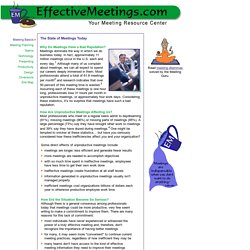
Meetings dominate the way in which we do business today. In fact, approximately 11 million meetings occur in the U.S. each and every day.1 Although many of us complain about meetings, we can all expect to spend our careers deeply immersed in them. Diversions - Meeting Cost Clock. Ever wonder how much money each meeting costs your company? The Meeting Cost Clock will help you find out. Simply download the clock and open it at your next meeting. Enter the number of participants in your meeting and their average hourly wage, then click start. The counter will tabulate your meeting cost as the clock runs.
Meeting Guru. Blessed Meeter, Below, I've listed a few techniques for dealing with dysfunctional behaviors in the meeting room. I hope these suggestions will help you put a stop to this negative behavior and get the most from your group each and every time you meet. Situation 1: Meeting Participant Drifts Off-Topic The leader should intervene and explain that the discussion is drifting away from the matter at hand. Meeting Behaviors: The Good, The Bad and The Ugly. February 24, 2010 | Author: PM Hut | Filed under: Communications Management, Project Management Best Practices Meeting Behaviors: The Good, The Bad and The Ugly By Andrew Buck I realized yesterday that it had been a while since I’d communicated my thoughts on the topic of Project/Program Management — I’ll thank a colleague for reminding me of that recently — so in keeping with that theme, I’ll use today’s article to explore Communication as a short topic.
In specific, no one goes for two decades in the profession without seeing the good, the bad, and the downright ugly of communication in a variety of environments, so I’ve focused today’s post on Meeting Behaviors. We’ve all been through meetings where we’ve asked ourselves why we were wasting an hour of time that could have been devoted to other important work. Goofus and Gallant. How to use meeting ground rules to shape behavior. High-performing organizations act intentionally. There are meeting ground rules since meetings are an ideal forum in which to both articulate and model target behavior. Meeting Owners (see: How to Run a Great Meeting/) on their own, with their core leadership team (see: How to Form a Core Leadership Group), and with help from a trained facilitator if available, develop three to six ground-rules to review with attendees. Each rule is consistent with how the leader wants people to behave in meetings and in general. When introduced for the first time, walkthrough each rule and encourage discussion to be sure it and the reason for it, are clear and to get the group’s buy-in.
Ten Annoying Meeting Behaviors. I spend more hours in meetings than out. Perhaps you do, too. I guess it is just a fact of corporate life. Over the years, I have cataloged a list of annoying meeting behaviors or just “AMBs” for short. None of these by themselves are that bothersome. 50327696. Welcome. Show Me Respect: Promoting Civility at the University of Missouri. Ep civility workplace. Civility in Public Discourse. Guy Burgess, Ph.D. and Heidi Burgess, Ph.D.
The increasingly vocal campaign for civility in public discourse reflects an understandable and widespread frustration with the current tenor of political debate. There is a growing realization that our inability to deal with a broad range of problems is largely attributable to the destructive ways in which the issues are being addressed. This raises a crucial and increasingly controversial question--what exactly do we mean by "civility"? Are you civil in the workplace? Six questions to ask yourself. Tccwebextra0514. Civility in the Workplace. Chamber Speaker Champions CivilityFinal Touch School. This article was published in the Wise County Messenger, Decatur, Texas. By Bob Buckel The only time most of us hear the word “civil,” it’s followed by “war.” What makes a good colleague? Academics weigh in (essay) Civility in America 2013 Exec Summary. Tips for promoting civility in public meetings 1. s2011110808 A 4. {3D49BDF5-E8A8-4C1F-8034-4A400E81C1DD}
Encouraging Civil Behavior in Large Classes. Essays on Teaching Excellence Toward the Best in the Academy Vol.15, No. 8, 2003-2004 A publication of The Professional &Organizational Development Network in Higher Education. The posting and use ofthis publication on your institution's WWW server is covered by an End UserLicense Agreement (EULA). Lama. No Time to Be Nice at Work. Photo. Empathia-advisor-2014-01. Lesson Plan - Effective Meetings. Organized meetings are important for the success of advisory committees as well as any other group. Whether monthly or quarterly, meetings provide groups the opportunity to meet face-to-face to develop group identity and cohesion; define a shared vision and purpose; and develop special projects, tasks and activities. While most of the actual work performed by the group occurs between meetings, meetings serve as catalysts for measuring progress towards tasks, sharing ideas, group decision making, and group recognition.
American Etiquette Coach on Rules When Attending a Meeting- Workplace Etiquette. Popplet.